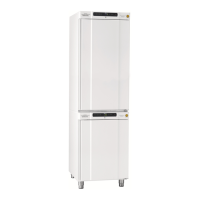25
b i o l ine
Menu Access +
Local alarm settings LAL
LHL [° C] Upper alarm limit. Code for activated alarm [A2]
LLL [° C] Lower alarm limit. Code for activated alarm [A3]
LHd [Min.] Delay of upper alarm limit
LLd [Min.] Delay of lower alarm limit
dA On/o Door alarm. Code for activated alarm [ A1]. [1=on/0=o]
dAd [Min.] Delay of door alarm
bU On/o Acoustic signal for alarm codes [ A1], [ A2] and [ A3]. [1=on/0=o]
External alarm settings EAL
EHL [° C] Upper alarm limit. Code for activated alarm [A4]
ELL [° C] Lower alarm limit. Code for activated alarm [A5]
EHd [Min.] Delay of upper alarm limit
ELd [Min.] Delay of lower alarm limit
dA On/o Door alarm. Code for activated alarm [ A1]. [1=on/0=o]
dAd [Min.] Delay of external door alarm
bU On/o Acoustic signal for external alarm codes [ A1], [ A4], [ A5]. [1=on/0=o]
Oset of sensors CAL
CA [° K] Oset setting of A-sensor. Reference sensor for the refrigeration system
CE [° K] Oset setting of E-sensor. Reference sensor for the display and alarms
CF [° K]
Oset setting of F-sensor. Reference sensor for the low temperature
protection
Electric low temperature
protection
FP
ACt On/o Activation/deactivation of low-temperature protection
tES On Test of low-temperature protection
SEt [° C] Setting of the cut-o temperature for the low-temperature protection
PrE […] Read out of the real-time temperature of the F-sensor
ALL Activation of escorted alarm limits. [FAS]=locked limits/[ESC]=follows setpoint
dEF Number of defrosts per 24 hours (4 is factory setting)
dPS Reference sensor for the display (A, E or F)
Buttons Duration Function
+
> 3 seconds Start or stop a defrost
+
> 6 seconds Activating/deactivating the keypad lock
- Shows temperature setpoint value
- Shows the highest registered temperature spike (since the last reset of alarm history)
-
Shows the lowest registered temperature spike
(since the last reset of alarm history)
+
> 3 seconds Reset alarm history
+
+
> 6 seconds Restore to factory settings
+
> 3 seconds Access to user menu and alarm settings
Acknowledge an acoustic alarm
Alarm code A1: Press to acknowledge.
Temperature alarm codes A2 and/or A3: Flashes in the display. Press to acknowledge.
The display will continue to ash if the temperature is outside the alarm limits.
Latching alarms: A2, A3, A4, A5
Due to the potential implications of alarms, the red danger triangle light will continue to remain on to warn the user of an alarm having
occured. Regardless of acknowleding, the light will remain on until an alarm history reset has been performed (holding and
for
more than 3 seconds), note that this will also reset temperature and alarm history.
Reading the alarm history – Example [A2]
[A2] ashes in the display – The temperature has exceeded the set value for the upper temperature limit, LHL.
Press
to acknowledge the [A2]. The display continues to ash, indicating that there is information in the alarm history.
Press , Htt (High temperature time) is shown, press to see for how long the temperature was above the set alarm limit.
Press to return to Htt. Press to reach Ht (Highest temperature). Press to read the highest recorded temperature during Htt.
Press to return to Ht and press again to leave the alarm history.
The procedure for reading an [A3] alarm is identical, apart from entering the alarm history with . When reading out temperatures
below set limits, the parameters are Ltt and Lt.
A ashing display with no alarm codes indicates that the alarm codes have been acknowledged, but the alarm history contains
information.
Resetting Max/Min and alarm history
Resetting of the Max/Min and alarm history is done by holding and for more than 3 seconds, an acoustic signal will be given
when reset is complete.
Display code Explanation
- 0 - Door is open
A1 Door alarm “dAd” from LAL and/or EAL has been activated
A2 Local upper alarm LHL is or has been activated
A3 Local lower alarm LLL is or has been activated
A4 External upper alarm EHL is or has been activated
A5 External lower alarm ELL is or has been activated
F1
Error on the main cabinet sensor. The refrigeration system will use an emergency program to make the cabi-
net run. Temperature stability will be aected. Service is required
F2 Error on the evaporator sensor. Service is required
F3 Error on the 1. condenser sensor. Service is required
F5 Error on the extra sensor. Service is required
F6 Error on low temperature protection sensor. Service is required
F7
F7 indicates that the temperature of the condenser is too high. Turn o the cabinet and check that the
condenser is not covered by undesirable items, and ensure that the condenser (and possibly lter) is clean.
Service is required if the problem is not alleviated
Error codes

